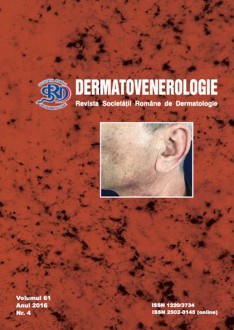The human papillomavirus (HPV) is a pathogen, frequently responsible for a multitude of mucous and cutaneous infections: of the mouth, airways, conjunctiva and of the anal-genital-urinary area. The incidence of the infection in the genital and perigenital areas in children is much lower than in adults, and is most often caused by the 6 and 11 HPV serotypes. Although it was considered that the sub-classification of HPV in skin and mucous types identifies the specific topography of the lesions, recent studies revealed HPV types in different location, both in children and in adults. Considering the theoretically long viral latency period (from 3 weeks to 8 months), it is difficult to identify the disease contraction modality, and multiple transmission ways are possible: vertical (perinatal), auto- or heteroinoculation. The diagnosis of condyloma acuminatum in children must exclude every time a possible sexual abuse.
We present the cases of 4 children, who presented soft papules, non-keratotic, some of them with cauliflower-like appearance, located in the genital, perigenital and perianal areas. The general and local clinical examination revealed no direct or indirect signs of a sexual abuse, the results of the usual blood tests being within the normal range, and no other sexually transmitted infections were identified.
The treatment was combined: cryotherapy with liquid nitrogen (-196 °C) or Podophyllotoxin (sol. 0,5%), associated with systemic immunomodulating therapy with Isoprinosine 50 mg/kg of body weight/day, considering the extension of the lesions and the high risk of relapse. The age of these patients was another challenge. The regular check-up examinations which were performed over a period of 12 months revealed neither relapses, nor newly appeared lesions in the genital or perigenital areas. The long term follow-up is recommended for these children/patients, even if there are no studies to clarify their risk of developing carcinomas at the adult age.
Clinical trials and experimental
TRANSMISSION MODALITIES OF THE HPV INFECTION IN THE ANOGENITAL AREA IN CHILDREN


